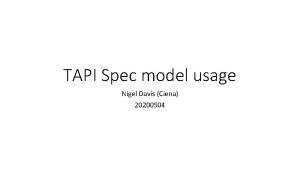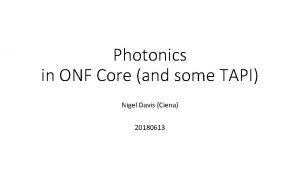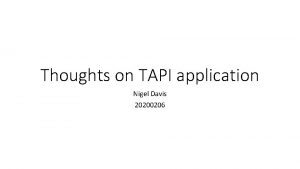Thoughts on TAPI application Nigel Davis 20200206 TAPI




- Slides: 4

Thoughts on TAPI application Nigel Davis 20200206

TAPI Application • Assumptions: • The client has one or more representations of the semantics (models) of the network • A representation may relate to a subset of the TAPI model (e. g. , just physical inventory) • A representation may compact or expand parts of the model (e. g. , Topology and Node are combined into a Forwarding. Domain) • A representation may be enriched with associations (e. g. , some or all of the one-way navigations are converted to two way navigations) • The client maintains a view of the instances of things in the network in each of its representational forms • On connection to the network the client gains alignment with the current state and maintains alignment as the state changes • Through the on-going process the client deals with the refactoring etc. as appropriate and deals with the challenges of asynchronous receipt (e. g. , the referencing entity arrives before the referenced entity) • The client has mapping rules to derive each of its representation of semantics from the TAPI interface representation • Each representation is essentially some form of pruning and refactoring of the TAPI model • As a consequence the TAPI server aims to optimise the process of maintaining alignment for the client • What the TAPI server is not: • A database supporting random queries and joins • A GUI server

Top level connection of a Connectivity. Service A Top Level Connection of a Connectivity. Service (1) is such that each CEP of the Connection (2) is from a NEP (3) that associates to a SIP (4) that a CSEP of the Connectivity. Service (5) relates to (6). (1) The CEP (reached by (2)) is related to the CSEP reached by (5) are related (7). (2) (5) (3) (7) (6) (4)

Exploring the connection partitioning and layering Each Top Level Connection of a Connectivity. Service (1) is identified and the lower level connections collected (2). For each Connection a neighbouring link can be identified by navigating through a CEP (3) to determine the supporting NEPS (4) which lead to the Link (5). Clearly a CEP that is referenced by a CSEP (6) of the Connectivity. Service (7) need not be explored. Each Link leads to the server Connections (8) which represents the trail (hence there is a layer transition). The overall process (2), (3), (4), (5) & (8) can be repeated for each Connection supporting a Link until the lowest layer is encountered. (2) (1) (8) (7) Layer transition (5) (3) (6) (4)





